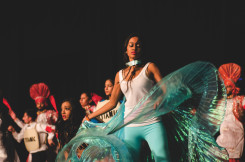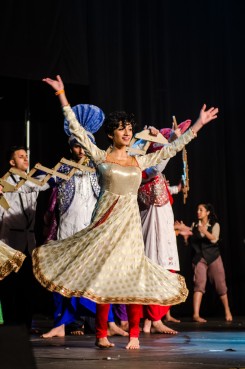The end of February marks the beginning of a flurry of nerves, endless sleepless nights, and intense practice for South Asian Alliance Dance teams across Ontario. In anticipation of one of the biggest inter-university dance competitions in Canada, these teams have been preparing for months for their chance to take home the title of champion and the $5,000 prize that comes with it. This is the North American Culture Show (nacs).
The nacs is a show of tremendous size and proportion. The 10 competing teams, comprised of 30 people each, are mostly old hats at this game. Teams from Brock, Guelph-Humber, McMaster-Mohawk, Ottawa-Carleton, Ryerson-George Brown, University of Toronto, University of Western Ontario, UOIT-DC, Waterloo-Laurier, and York-Seneca participate. The rules are straightforward: each school must portray a theme in their 10 minute performance. No props. No sets. And most importantly, the dances must fit into four different genres: Bhangra, Bollywood, Classical Indian, and Fusion. Simple enough, right? That’s what I thought too.
When I auditioned for the University of Toronto St. George team in my first year, I had no idea what I was getting myself into. Sure, it was a dance competition, but how intense could it really be? By the time the competition swung around, I no longer suffered from any such delusions. nacs was intense, nacs was what we were dancing our hearts out for, and as the underdogs, nacs was our opportunity to shine.
This year, things went a little differently. For the first time, the University of Toronto decided that strength was in unity, students from all three campuses joining to create one powerhouse: Team U of T. As a choreographer, I knew the game was upped — schools were expecting big things from us, and we planned on bringing it. By this time, I was well-acquainted with the strange cult-like following the nacs inspires, in some cases being the sole reason for a student to take a fifth or sometimes sixth year of undergrad. With even alumni dancing on the team, there was no question that we wanted to win.
We started pulling all-night rehearsals a little after reading week. There came a point where I began to dream about when I had actually had time in between classes and dance for something else. But there was a flip side. If the nacs had become my life, then so had my team. Going through this trial of fire together, we formed a bond over our shared love of dance and our desire to win. Within the team, I found a group of like-minded individuals devoted to dance, some of whom were part of external dance organizations and companies. Entering the competition on March 8, I knew that no matter how we placed, I had built a strong network of people in the dance world that I could rely on.
nacs itself was a larger-than-life experience. While we ended up placing fifth, we won ‘Best Artistic Design’ and ‘Best Theme.’ However, what really stood out to me this time was the strong display of interconnectedness that was evident between the teams. Although rivals, veteran dancers knew other dancers from different schools, and even cheered each other on. I was approached by a student from York at the end of the nacs, asking if I wanted to be part of a team he was putting together for another competition at the end of June. This sense of camaraderie pervaded the entire event, and even extended to the judges, professionals in the dance world, with whom students could network with in the future.
The platform the nacs provides for students to foray into the professional dance sphere, connect with talented students at other schools, and create lasting bonds within a university itself, is undeniable. In the end, it’s about so much more than the dance or what you win — it’s also about the people you meet and the relationships you form.
I interviewed two veteran dancers, Tahir Ali Rana and Kishan Chouhan, from Team U of T, to further exploring the kinship that the nacs creates.
THE VARSITY
Do you see nacs as connecting people, both within and in between teams?
TAHIR ALI RANA
Within a team, you have 30 dancers … and they have to spend practically almost the whole school year together, and they have a common goal, and they know that they have to build towards that goal together and that each of them is an elementary part of that production. It connects them in that sense that each of them are dependent on one another, and it connects them in that everyone is in different years of study so you come to realize that you’re there to dance. But there’s other foundations from which people can seek assistance … you take more away from it than you initially assume to.
KISHAN CHOUHAN
Well, within a team I believe you definitely build a unity. Definitely closer to the competition where [practices run] after classes, or even into the next morning you really get a sense of family with your team. With other teams, there are events such as socials and formals where you get to mix and mingle as well as the competition itself…
THE VARSITY
How do you see networks being formed within the competition?
TAHIR ALI RANA
A lot of students who participate in this organization are actually from certain dance teams. By interacting with those individuals, they’re able to recognize your talents as a dancer, and they are able to look to you … if they have competitions outside of nacs, if they have gigs or performances where they need additional dancers. There was the halftime show for the Raptors where a lot of dancers from many different campuses got together and created the halftime performance. Personally speaking, [with] last year’s Bollywood judge Puja Amin … this year we went to her seeking costume rentals for the show… You get recognized being on that stage, and you get to meet and introduce yourself to these judges… You’re creating a profile for yourself as an excellent dancer and getting recognized for that.
KISHAN CHOUHAN
Definitely, since I have been in this competition for five years, I have had the opportunity to network with some judges. They would notice the work that I did, and they would contact me and ask me to help them or dance with them… Specifically last year the classical judge had a gig she needed dancers for, and she called upon our school… It was a great way to network and to get further opportunities because she still is in contact with me for other shows, to the point where she is able to fund professional classes to brush up on the dances for her shows, which is really nice…Also with other South Asian people in the gta, [nacs] definitely brings you together and makes you more aware that … there are a lot of other people, and you get to find out where you fit in. Networks always impact your life… I believe you are nobody without the people you know because they inevitably will get you where you want to be.








